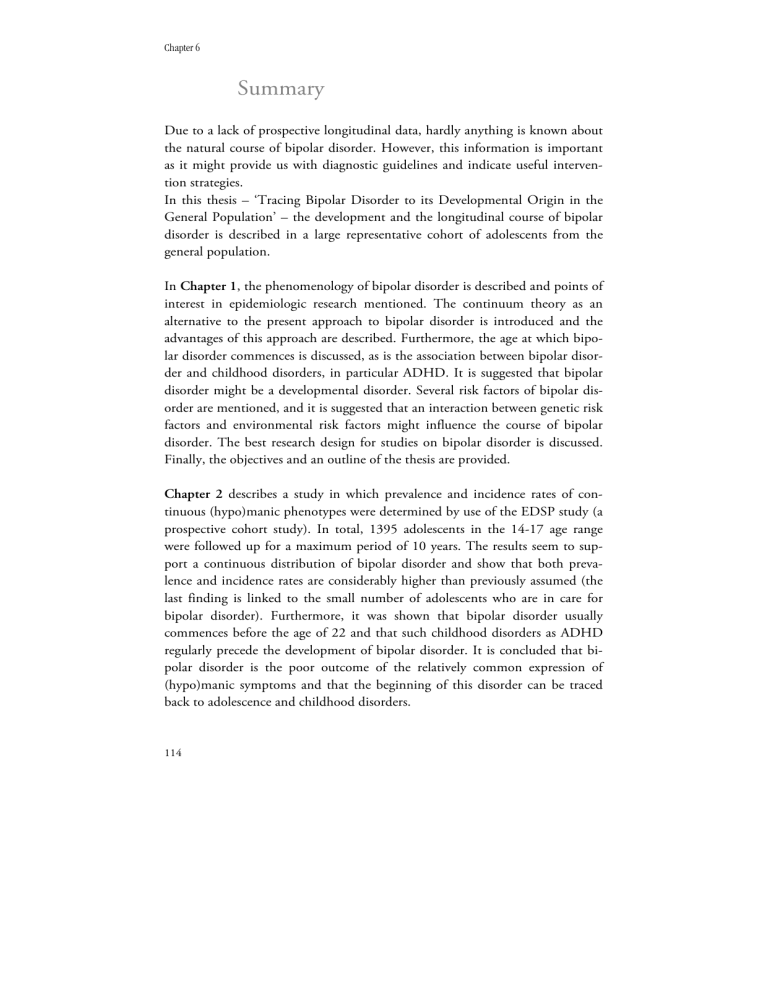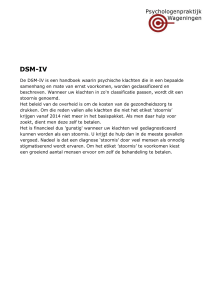
Chapter 6
Summary
Due to a lack of prospective longitudinal data, hardly anything is known about
the natural course of bipolar disorder. However, this information is important
as it might provide us with diagnostic guidelines and indicate useful intervention strategies.
In this thesis – ‘Tracing Bipolar Disorder to its Developmental Origin in the
General Population’ – the development and the longitudinal course of bipolar
disorder is described in a large representative cohort of adolescents from the
general population.
In Chapter 1, the phenomenology of bipolar disorder is described and points of
interest in epidemiologic research mentioned. The continuum theory as an
alternative to the present approach to bipolar disorder is introduced and the
advantages of this approach are described. Furthermore, the age at which bipolar disorder commences is discussed, as is the association between bipolar disorder and childhood disorders, in particular ADHD. It is suggested that bipolar
disorder might be a developmental disorder. Several risk factors of bipolar disorder are mentioned, and it is suggested that an interaction between genetic risk
factors and environmental risk factors might influence the course of bipolar
disorder. The best research design for studies on bipolar disorder is discussed.
Finally, the objectives and an outline of the thesis are provided.
Chapter 2 describes a study in which prevalence and incidence rates of continuous (hypo)manic phenotypes were determined by use of the EDSP study (a
prospective cohort study). In total, 1395 adolescents in the 14-17 age range
were followed up for a maximum period of 10 years. The results seem to support a continuous distribution of bipolar disorder and show that both prevalence and incidence rates are considerably higher than previously assumed (the
last finding is linked to the small number of adolescents who are in care for
bipolar disorder). Furthermore, it was shown that bipolar disorder usually
commences before the age of 22 and that such childhood disorders as ADHD
regularly precede the development of bipolar disorder. It is concluded that bipolar disorder is the poor outcome of the relatively common expression of
(hypo)manic symptoms and that the beginning of this disorder can be traced
back to adolescence and childhood disorders.
114
Summary
In Chapter 3, the EDSP study is used to investigate two hypotheses. First, it is
investigated whether there is an association between the number of
(hypo)manic and/or depressive symptoms and the development of DSM-IV
bipolar disorder or the use of mental health care. Second, it is investigated
whether there is an association with the level of persistence of (hypo)manic
and/or depressive symptoms. In total, 2029 adolescents and young adults aged
14-24 years were followed up for a period of approximately 8.3 years. A doseresponse relationship was found for both the number of symptoms and the level
of persistence as regards the risk of developing a DSM-IV bipolar disorder or
the use of mental health care. Even more interesting, however, is that the combination of a high number of symptoms with a high level of persistence (i.e.
many symptoms over a long period of time) gave the highest risk of a DSM-IV
bipolar disorder or use of mental health care. The results support the continuum theory of bipolar disorder and emphasize the importance of the longitudinal follow-up of adolescents with affective symptoms.
Chapter 4 describes a longitudinal study (the EDSP study) in which it was
investigated for both (hypo)manic symptoms and bipolar symptoms (i.e. depressive symptoms occurring in the context of (hypo)mania) whether risk factors can increase the risk of experiencing these symptoms for the first time (onset) and increase the risk that transitory symptom expressions become persistent
(persistence). The risk factors investigated are a positive family history of mood
disorders, negative life events (early trauma/loss of parent), substance use (alcohol/cannabis), ADHD and temperamental/personality traits. The results indicate that
cannabis use and novelty seeking increase the risk of onset of (hypo)manic
symptoms, whereas early trauma, novelty seeking and harm avoidance are associated with increased onset of bipolar symptoms. Novelty seeking decreases the
risk of persistence of (hypo)manic symptoms while reward dependence increases
the risk of persistence of bipolar symptoms.
It is concluded that mood abnormalities in the context of bipolar disorder may
arise stepwise, and that different biological and psychological mechanisms
might underlie (hypo)manic and depressive dimensions of bipolar disorder.
Chapter 5 presents an overview of the most important findings of the previous
chapters. An interactive developmental model is introduced in which these
findings can be integrated. A profound discussion of possible biopsychological
115
Chapter 6
mechanisms that might explain the different characteristics of this model is
provided. Finally, clinical implications of the findings and suggestions for future research are given.
Samenvatting
116
Samenvatting
Samenvatting
Als gevolg van een gebrek aan prospectief-longitudinaal onderzoek is er nauwelijks informatie over het natuurlijk beloop van bipolaire stoornis. Desondanks is deze informatie van het grootste belang aangezien het ons kan voorzien
van richtlijnen voor diagnostiek evenals nuttige interventie strategieën. In dit
proefschrift, getiteld “Tracing Bipolar Disorder to its Developmental Origin in
the General Population” wordt de ontwikkeling en het longitudinaal beloop
van de bipolaire stoornis beschreven in een groot representatief cohort van adolescenten uit de algemene populatie.
In hoofdstuk 1 wordt de fenomenologie van bipolaire stoornis beschreven en
worden aandachtspunten voor epidemiologisch onderzoek genoemd. De continuüm opvatting wordt geïntroduceerd als alternatief op de huidige benadering
van bipolaire stoornis, en de verschillende voordelen van deze benadering
worden beschreven. Verder wordt ingegaan op het tijdstip van ontstaan van
bipolaire stoornis en de associatie tussen bipolaire stoornis en stoornissen van de
kindertijd zoals ADHD. Er wordt gesuggereerd dat bipolaire stoornis mogelijk
een ontwikkelingsstoornis is. Een aantal risicofactoren voor bipolaire stoornis
wordt genoemd, en er wordt geopperd dat de interactie van genetische risicofactoren met omgevingsfactoren het beloop van bipolaire stoornis kan beïnvloeden. De beste onderzoeksopzet voor onderzoek van bipolaire stoornis wordt
besproken. Tot slot worden de doelstellingen weergegeven alsmede een uiteenzetting van het proefschrift.
Hoofdstuk 2 beschrijft een studie waarin de prevalentie en incidentie van continue (hypo)mane fenotypes bepaald worden. Hierbij is gebruik gemaakt van de
EDSP-studie, een prospectief cohort onderzoek. In totaal werden 1395 adolescenten tussen de 14 en 17 jaar gedurende een periode van maximaal 10 jaar
gevolgd. De resultaten lijken een continue verdeling van bipolaire stoornis te
ondersteunen en tonen aan dat zowel prevalentie als incidentie cijfers van deze
stoornis beduidend hoger zijn dan voorheen gedacht, waarbij het laatste in verband werd gebracht met het kleine aantal adolescenten dat in zorg is voor bipolaire stoornis. Tevens werd gezien dat de stoornis meestal reeds voor het 22e
levensjaar begint en dat stoornissen van de kindertijd zoals ADHD regelmatig
voorafgaan aan het ontstaan van bipolaire stoornis. Er wordt geconcludeerd dat
117
Chapter 6
bipolaire stoornis de klinische manifestatie van relatief frequent voorkomende
(hypo)mane symptomen is en dat het begin van deze stoornis herleid kan
worden naar de adolescentie en stoornissen die reeds in de kindertijd ontstaan
zijn.
In hoofdstuk 3 worden met behulp van de EDSP-studie twee hypothesen onderzocht. Allereerst wordt gekeken of er een associatie is tussen het aantal
(hypo)mane en/of depressieve symptomen en (1) het ontstaan van een DSM-IV
bipolaire stoornis of (2) het krijgen van psychische hulp. Ten tweede wordt
onderzocht of er een associatie is met de mate van persistentie van (hypo)mane
en/of depressieve symptomen. In totaal werden 2029 adolescenten en jong volwassen tussen de 14 en 24 jaar gedurende ongeveer 8,3 jaar vervolgd. Er werd
een dosis-respons relatie gevonden voor zowel aantal symptomen als mate van
persistentie wat betreft het vergroten van het risico op een DSM-IV bipolaire
stoornis en het krijgen van psychische hulp. Nog interessanter is echter, dat de
combinatie van een hoog aantal symptomen met een hoge mate van persistentie
(i.c. veel symptomen gedurende langere tijd) het grootste risico op een stoornis
of psychische hulp gaf. De resultaten ondersteunen de continuüm theorie voor
bipolaire stoornis en benadrukken het belang van longitudinale vervolging van
adolescenten met affectieve symptomen.
Hoofdstuk 4 beschrijft een longitudinale studie (de EDSP-studie) waarin voor
zowel (hypo)mane symptomen als bipolaire symptomen (i.c. depressieve symptomen in het kader van (hypo)mane symptomen) bepaald wordt of risicofactoren (i) het risico op het ontstaan van symptomen kan verhogen en (ii) het
risico op het persistent worden van de (doorgaans tijdelijke) symptomen kan
verhogen. De risicofactoren die worden onderzocht zijn een positieve familiegeschiedenis voor stemmingsstoornissen, negatieve life events (trauma/verlies
van ouder), middelengebruik (alcohol/cannabis), ADHD en temperament/persoonlijkheidsfactoren. De resultaten tonen aan dat cannabis gebruik en
“novelty seeking” het risico op het ontstaan van (hypo)mane symptomen verhogen, terwijl trauma, “novelty seeking” en “harm avoidance” geassocieerd zijn
met een toegenomen ontstaan van bipolaire symptomen. Novelty seeking verlaagt het risico op persistentie van (hypo)mane symptomen terwijl “reward
dependence” het risico op persistentie van bipolaire symptomen doet toenemen.
Geconcludeerd wordt dat afwijkingen in de stemming in de context van bipolaire stoornis mogelijk stapsgewijs ontstaan en dat verschillende biologische en
118
Samenvatting
psychologische mechanismen ten grondslag zouden kunnen liggen van de (hypo)mane en depressieve dimensie van bipolaire stoornis.
Hoofdstuk 5 biedt een overzicht van de belangrijkste bevindingen van de voorgaande hoofdstukken. Een interactief ontwikkelingsmodel wordt geïntroduceerd waarin deze bevindingen geïntegreerd kunnen worden. Een diepgaandere
discussie van mogelijke biopsychologische mechanismen vindt plaats die de
verschillende kenmerken van het model kunnen verklaren. Tot slot worden
klinische implicaties van de bevindingen gegeven en aanbevelingen voor toekomstig onderzoek gedaan.
119












